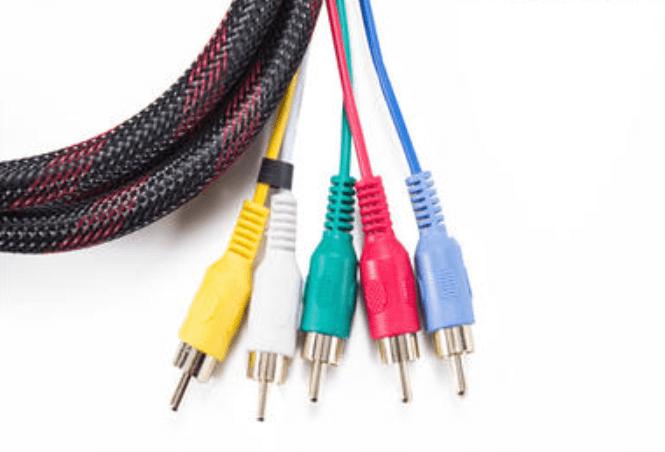
Everthing about the RCA Cable
RCA cables are a popular choice for audio and video connections due to their simplicity and widespread compatibility. In this article, we will delve into the world of RCA cables, discussing their purpose, construction, and usage. We will also clarify the distinction between RCA cables and coaxial cables, and explore the analog and unbalanced nature of RCA connections.
What is RCA Cable?
RCA cables, also known as phono cables, are a type of connector commonly used for transmitting audio and video signals. The name "RCA" is derived from the Radio Corporation of America, which introduced this connector in the 1940s.
RCA cables consist of a plug with a cylindrical metal body and a central pin, along with two separate wires, usually color-coded red and white for audio, and yellow for composite video. The plugs are typically color-coded to match the corresponding jacks on devices.
RCA cables consist of a plug with a cylindrical metal body and a central pin, along with two separate wires, usually color-coded red and white for audio, and yellow for composite video. The plugs are typically color-coded to match the corresponding jacks on devices.
Why Do RCA Cables Have Two Wires?
RCA cables utilize two wires, typically referred to as conductors, to transmit audio signals. The dual-wire configuration enables the separation of left and right audio channels, providing stereo sound.
In audio systems, the left and right audio signals are carried separately through these wires to maintain channel separation and enhance the overall audio experience. This arrangement also enables easy identification and connection of the cables.
In audio systems, the left and right audio signals are carried separately through these wires to maintain channel separation and enhance the overall audio experience. This arrangement also enables easy identification and connection of the cables.
What Is an RCA Cable Used For?
RCA cables have a wide range of applications across various audio and video devices. They are commonly used to connect DVD players, gaming consoles, set-top boxes, and audio equipment to televisions, amplifiers, or receivers.
These cables are also employed in home theater systems, DJ setups, and professional audio/video installations. RCA cables are particularly suitable for analog audio connections, such as stereo audio signals, as well as composite video signals.
These cables are also employed in home theater systems, DJ setups, and professional audio/video installations. RCA cables are particularly suitable for analog audio connections, such as stereo audio signals, as well as composite video signals.
Is RCA the Same as Coaxial Cable?
RCA cables and coaxial cables are two distinct types of connectors. While both are commonly used for audio and video connections, they differ in design and functionality.
RCA cables consist of separate connectors for each audio or video signal, whereas coaxial cables utilize a single connector for both audio and video transmission. Coaxial cables are typically used for digital audio/video signals, such as those found in cable television, satellite TV, and high-definition video applications.
RCA cables consist of separate connectors for each audio or video signal, whereas coaxial cables utilize a single connector for both audio and video transmission. Coaxial cables are typically used for digital audio/video signals, such as those found in cable television, satellite TV, and high-definition video applications.
Are RCA Cables Both Analog and Unbalanced?
RCA cables are predominantly used for analog audio connections. They carry analog signals, which are continuous electrical representations of audio waveforms.
However, RCA cables can also be used for transmitting digital audio signals, depending on the device and application.
Regarding the balance, RCA cables are considered unbalanced. Unbalanced connections use two conductors—an inner signal-carrying wire and an outer ground wire—without the additional third wire found in balanced connections.
While unbalanced connections are more susceptible to noise interference over long cable runs, RCA cables are still widely used due to their simplicity, cost-effectiveness, and compatibility with various consumer audio and video devices.
However, RCA cables can also be used for transmitting digital audio signals, depending on the device and application.
Regarding the balance, RCA cables are considered unbalanced. Unbalanced connections use two conductors—an inner signal-carrying wire and an outer ground wire—without the additional third wire found in balanced connections.
While unbalanced connections are more susceptible to noise interference over long cable runs, RCA cables are still widely used due to their simplicity, cost-effectiveness, and compatibility with various consumer audio and video devices.
Conclusion
RCA cables play a crucial role in connecting audio and video devices, providing a simple and effective means of transmission. With their dual-wire configuration and widespread compatibility, RCA cables are an industry standard for analog audio connections and composite video signals.
While distinct from coaxial cables, RCA cables excel in transmitting stereo audio and composite video, catering to the needs of both home users and professional audio/video applications. Understanding the nature and purpose of RCA cables empowers users to make informed decisions when establishing connections and optimizing their audiovisual experiences.
While distinct from coaxial cables, RCA cables excel in transmitting stereo audio and composite video, catering to the needs of both home users and professional audio/video applications. Understanding the nature and purpose of RCA cables empowers users to make informed decisions when establishing connections and optimizing their audiovisual experiences.







Leave a comment